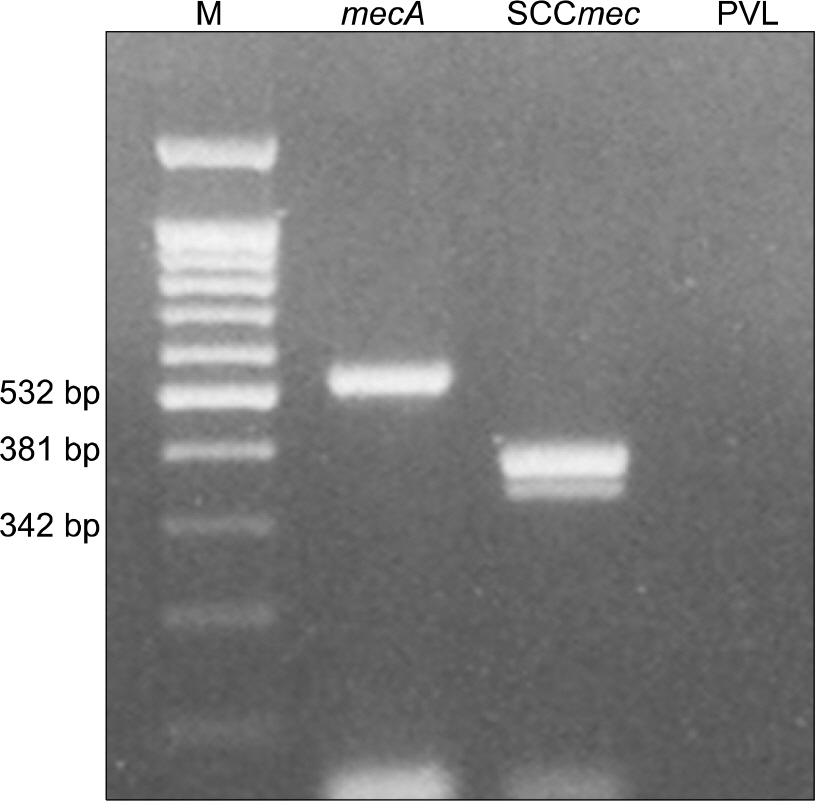Korean J Clin Microbiol.
2008 Oct;11(2):129-131. 10.5145/KJCM.2008.11.2.129.
A Fatal Case of Infective Endocarditis Caused by Community-Associated Methicillin-Resistant Staphylococcus aureus ST72 in Korea
- Affiliations
-
- 1Department of Internal Medicine, Chung-Ang University College of Medicine, Seoul, Korea. drjwchung@cau.ac.kr
- KMID: 1480981
- DOI: http://doi.org/10.5145/KJCM.2008.11.2.129
Abstract
- The advent of community-associated methicillin-resistant Staphylococcus aureus (CA-MRSA) has been a worldwide threat to public health for the past decade. We report a fatal case of infective endocarditis caused by a non-USA300, Panton-Valentine leukocidin toxin-negative CA-MRSA clone. This is a serious case of CA-MRSA infection caused by a sequence type (ST) 72 clone, which is one of the common CA-MRSA clones circulating in Korea where serious CA-MRSA infections have been rare.
MeSH Terms
Figure
Reference
-
References
1. Diederen BM and Kluytmans JA. The emergence of infections with community-associated methicillin resistant Staphylococcus aureus. J Infect. 2006; 52:157–68.2. Zetola N, Francis JS, Nuermberger EL, Bishai WR. Community-acquired methicillin-resistant Staphylococcus aureus: an emerging threat. Lancet Infect Dis. 2005; 5:275–86.3. Kim ES, Song JS, Lee HJ, Choe PG, Park KH, Cho JH, et al. A survey of community-associated methicillin-resistant Staphylococcus aureus in Korea. J Antimicrob Chemother. 2007; 60:1108–14.
Article4. Strommenger B, Kettlitz C, Werner G, Witte W. Multiplex PCR assay for simultaneous detection of nine clinically relevant antibiotic resistance genes in Staphylococcus aureus. J Clin Microbiol. 2003; 41:4089–94.5. Oliveira DC and de Lencastre H. Multiplex PCR strategy for rapid identification of structural types and variants of the mec element in methicillin-resistant Staphylococcus aureus. Antimicrob Agents Chemother. 2002; 46:2155–61.6. Lina G, Piémont Y, Godail-Gamot F, Bes M, Peter MO, Gauduchon V, et al. Involvement of Panton-Valentine leukocidin-producing Staphylococcus aureus in primary skin infections and pneumonia. Clin Infect Dis. 1999; 29:1128–32.
Article7. Enright MC, Day NP, Davies CE, Peacock SJ, Spratt BG. Multilocus sequence typing for characterization of methicillin-resistant and methicillin-susceptible clones of Staphylococcus aureus. J Clin Microbiol. 2000; 38:1008–15.8. Ko KS, Lee JY, Baek JY, Peck KR, Rhee JY, Kwon KT, et al. Characterization of Staphylococcus aureus nasal carriage from children attending an outpatient clinic in Seoul, Korea. Microb Drug Resist. 2008; 14:37–44.9. Bahrain M, Vasiliades M, Wolff M, Younus F. Five cases of bacterial endocarditis after furunculosis and the ongoing saga of community-acquired methicillin-resistant Staphylococcus aureus infections. Scand J Infect Dis. 2006; 38:702–7.
Article10. Tsigrelis C, Armstrong MD, Vlahakis NE, Batsis JA, Baddour LM. Infective endocarditis due to community-associated methicillin-resistant Staphylococcus aureus in injection drug users may be associated with Panton-Valentine leukocidin-negative strains. Scand J Infect Dis. 2007; 39:299–302.
Article11. Millar BC, Prendergast BD, Moore JE. Community-associated MRSA (CA-MRSA): an emerging pathogen in infective endocarditis. J Antimicrob Chemother. 2008; 61:1–7.
Article
- Full Text Links
- Actions
-
Cited
- CITED
-
- Close
- Share
- Similar articles
-
- A Case of Primary Infective Endocarditis Caused by Community-Associated Methicillin-Resistant Staphylococcus aureus in a Healthy Individual and Colonization in the Family
- A case of tricuspid valve endocarditis with septic pneumonia caused by methicillin-resistant Staphylococcus aureus in a healthy woman
- Community-acquired Methicillin-resistant Staphylococcus aureus Bacteremia Complicated by Acute Cholecystitis
- Fatal Peripheral Septic Thrombophlebitis Complicated with Infective Endocarditis due to Methicillin-resistant Staphylococcus aureus: A Case Report with Autopsy Findings
- A case of multiple furunculosis caused by methicillin-resistant staphylococcs aureus


